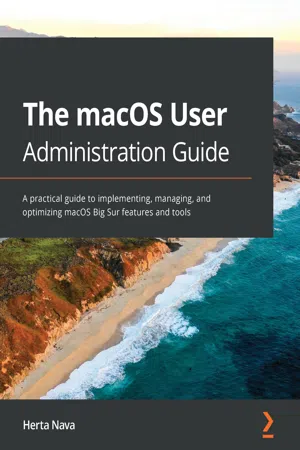
The macOS User Administration Guide
A practical guide to implementing, managing, and optimizing macOS Big Sur features and tools
- 804 pages
- English
- ePUB (mobile friendly)
- Available on iOS & Android
The macOS User Administration Guide
A practical guide to implementing, managing, and optimizing macOS Big Sur features and tools
About this book
Explore macOS tools and architecture for executing support tasks and system administration, and prepare for the Apple Certified Support Professional (ACSP) certification exam
Key Features
- Delve into macOS Big Sur, from installation to managing apps and optimizing your environment
- Become an Apple Certified Support Professional (ACSP) with this comprehensive macOS support guide
- The book is not intended to be a user guide, it covers concepts pertinent for a user acting as an administrator
Book Description
Apple is pushing the capabilities of its technologies to help users achieve high performance, including improvements in its OS running across all Mac systems, macOS, and new technologies such as M1 Silicon chips. This book walks you through macOS from a system administration and support point of view, exploring its latest features.
The book starts by explaining macOS architecture, installation, and startup processes to enable you to get started with the OS. You'll learn how to manage users and discover techniques for user security and privacy. Moving on, you'll get to grips with the macOS file system and learn to manage disks, volumes, and partitions for effective file management. Most of the examples covered in this book are from an administrator's perspective; however, when relevant, a standard user's perspective is also presented. You'll find illustrations for Mac systems running macOS 11 (Big Sur), and when necessary, for macOS 10.15 (macOS Catalina). Finally, you'll explore advanced topics such as networking and using command-line tools for administration tasks.
By the end of this macOS book, you'll be well-versed with macOS features, administration tasks, and best practices. You'll also be able to apply the concepts to increase your chances of success in obtaining Apple certifications such as Apple Certified Support Professional (ACSP).
What you will learn
- Understand the fundamentals of the macOS system and architecture
- Configure key services and perform essential troubleshooting in your Mac system
- Install, update, and configure your local macOS system and identify the stages of the startup process
- Create and manage a local user account and set up your customized macOS environment
- Manage your file systems, storage, and permissions
- Explore practices and techniques to work with apps, networks, and security for your Mac system
- Delve into administration tasks such as managing service resources and peripherals
Who this book is for
If you are a Mac system administrator, support and help desk technician or engineer, or Mac power user looking to explore macOS architecture and tooling, then this book is for you. The book assumes beginner-level knowledge of the macOS environment and system administration.
Frequently asked questions
- Essential is ideal for learners and professionals who enjoy exploring a wide range of subjects. Access the Essential Library with 800,000+ trusted titles and best-sellers across business, personal growth, and the humanities. Includes unlimited reading time and Standard Read Aloud voice.
- Complete: Perfect for advanced learners and researchers needing full, unrestricted access. Unlock 1.4M+ books across hundreds of subjects, including academic and specialized titles. The Complete Plan also includes advanced features like Premium Read Aloud and Research Assistant.
Please note we cannot support devices running on iOS 13 and Android 7 or earlier. Learn more about using the app.
Information
- Understanding apps in macOS
- Using the App Store
- Installing and managing apps
- Managing app extensions
- Sharing apps
- Managing documents
Technical requirements
- Basic knowledge of the macOS environment
- A Mac computer with administrator privileges
Understanding apps in macOS
- Supported macOS environments
- App compatibility
Supported macOS environments
- Native macOS
- Universal macOS binary
- Unix-based
- Open source
Native macOS
- Single-window utility app: A good example of this type of app is the calculator.
- Single-window library-style app: A good example of this type of app is the iPhoto app, which has only one window. From that single window, the user interacts with its collection or library of items.
- Multi-window document-based app: A good example of this is the Text Edit app, which uses a separate window for every document you open.
Table of contents
- Title Page
- Copyright and Credits
- Dedication
- Contributors
- Preface
- Overview of the macOS System, Architecture, and Features
- Installing and Configuring macOS
- The Start Up Process
- User Accounts Management
- Managing User Security and Privacy
- The macOS File System: Disks, Volumes, and Partitions
- Understanding Ownership and Permissions
- System Resources and Shortcuts
- Understanding Metadata and Searching
- Managing Apps and Documents
- Backups and Archiving
- Networking in macOS
- Using macOS Network Services
- Using macOS Sharing Services
- Managing Security in macOS
- Using the Command Line
- Troubleshooting Tips
- About Packt